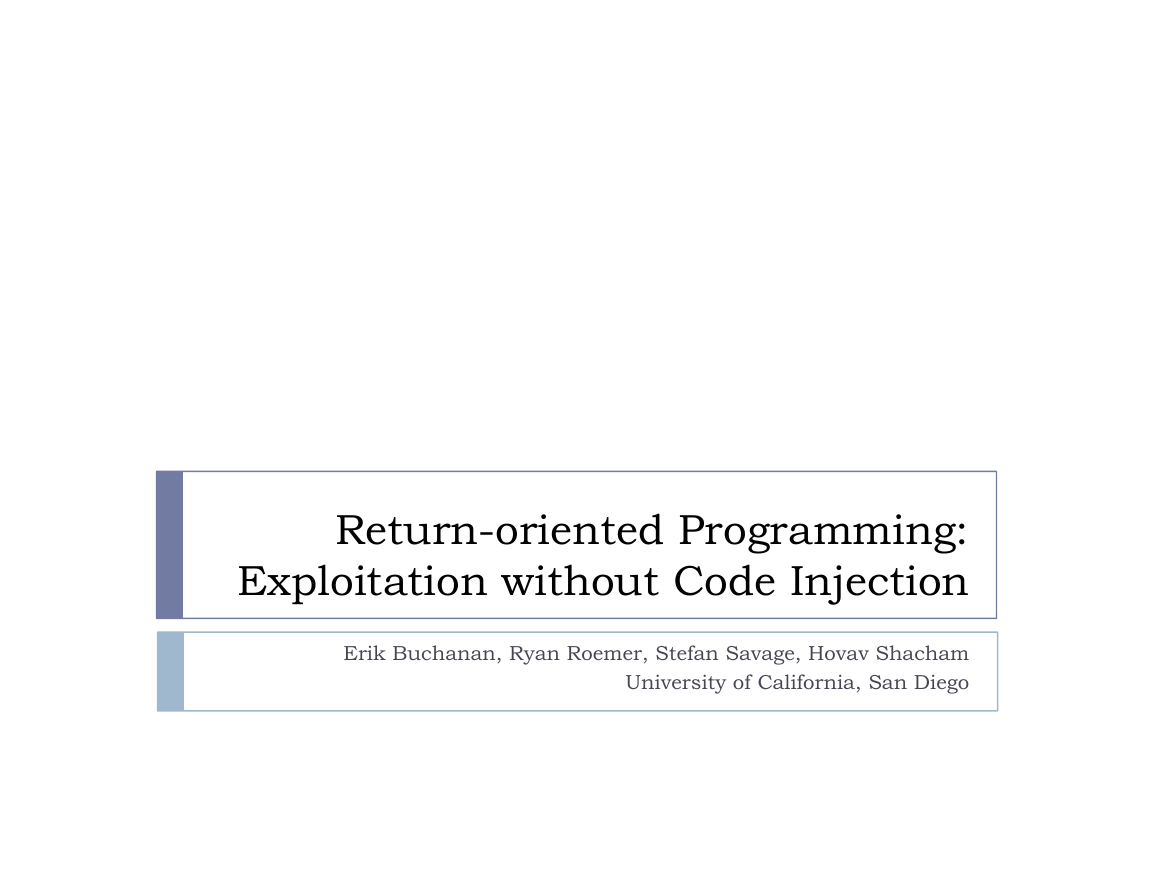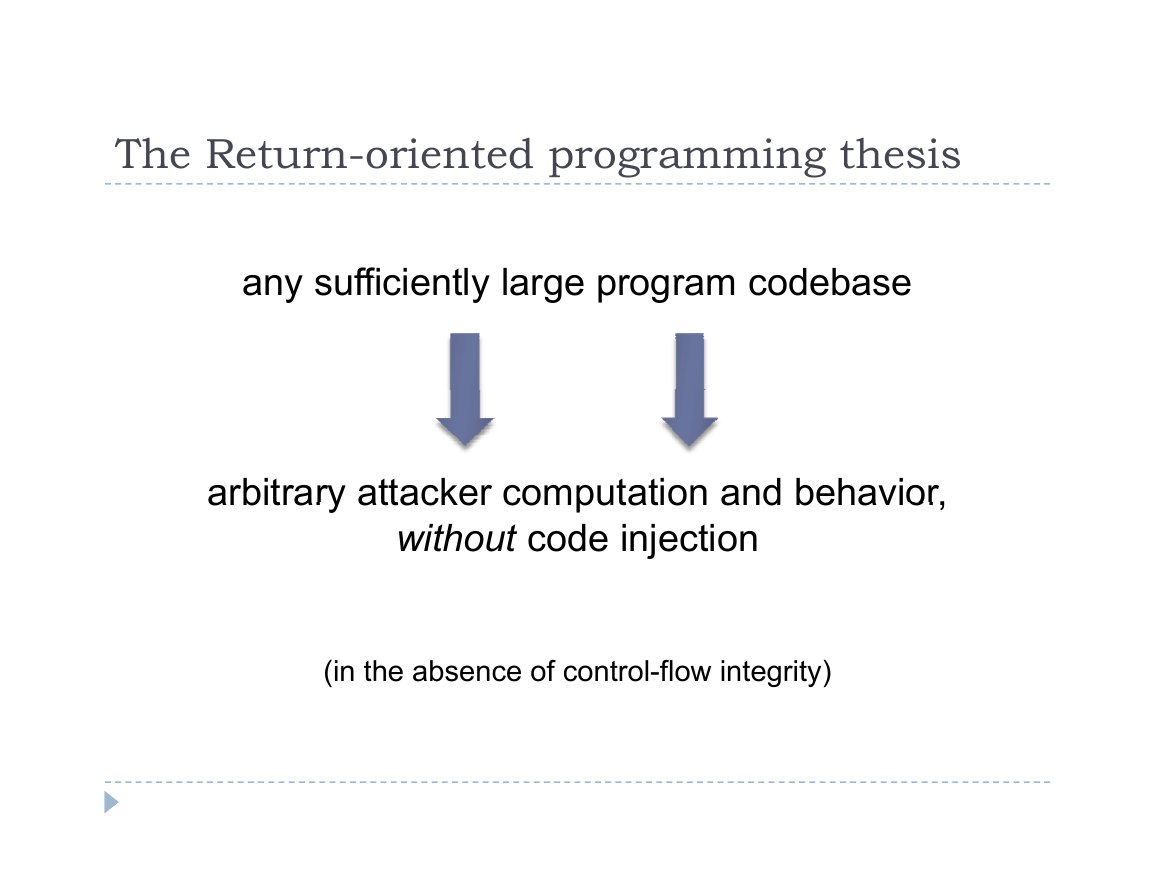Return-oriented Programming:
Exploitation without Code Injection
Erik Buchanan, Ryan Roemer, Stefan Savage, Hovav Shacham
University of California, San Diego
�
Bad code versus bad behavior
Bad code versus bad behavior
“Bad”
Bad
behavior
“Good”
Good
behavior
Attacker
d
code
Application
d
code
Problem: this implication is
false!
�
The Return-oriented programming thesis
The Return oriented programming thesis
any sufficiently large program codebase
any sufficiently large program codebase
arbitrary attacker computation and behavior,
arbitrary attacker computation and behavior,
without code injection
(in the absence of control-flow integrity)
�
Security systems endangered:
Security systems endangered:
W-xor-X aka DEP
Linux OpenBSD Windows XP SP2 MacOS X
Linux, OpenBSD, Windows XP SP2, MacOS X
Hardware support: AMD NX bit, Intel XD bit
p
Trusted computing
g
Code signing: Xbox
Binary hashing: Tripwire, etc.
… and others
�
Return-into-libc and W^X
�
W-xor-X
W xor X
Industry response to code injection exploits
Marks all writeable locations in a process’ address
Marks all writeable locations in a process address
space as nonexecutable
Deployment: Linux (via PaX patches); OpenBSD;
p y
;
Windows (since XP SP2); OS X (since 10.5); …
); p
(
p
Hardware support: Intel “XD” bit, AMD “NX” bit
(and many RISC processors)
�
Return-into-libc
Return into libc
Divert control flow of exploited program into libc code
system() printf()
system(), printf(), …
No code injection required
Perception of return-into-libc: limited, easy to defeat
Attacker cannot execute arbitrary code
Attacker relies on contents of libc — remove system()?
We show: this perception is false.
�
The Return-oriented programming thesis:
return-into-libc special case
return into libc special case
attacker control of stack
attacker control of stack
arbitrary attacker computation and behavior
arbitrary attacker computation and behavior
via return-into-libc techniques
(given any sufficiently large codebase to draw on)
�
















 2023年江西萍乡中考道德与法治真题及答案.doc
2023年江西萍乡中考道德与法治真题及答案.doc 2012年重庆南川中考生物真题及答案.doc
2012年重庆南川中考生物真题及答案.doc 2013年江西师范大学地理学综合及文艺理论基础考研真题.doc
2013年江西师范大学地理学综合及文艺理论基础考研真题.doc 2020年四川甘孜小升初语文真题及答案I卷.doc
2020年四川甘孜小升初语文真题及答案I卷.doc 2020年注册岩土工程师专业基础考试真题及答案.doc
2020年注册岩土工程师专业基础考试真题及答案.doc 2023-2024学年福建省厦门市九年级上学期数学月考试题及答案.doc
2023-2024学年福建省厦门市九年级上学期数学月考试题及答案.doc 2021-2022学年辽宁省沈阳市大东区九年级上学期语文期末试题及答案.doc
2021-2022学年辽宁省沈阳市大东区九年级上学期语文期末试题及答案.doc 2022-2023学年北京东城区初三第一学期物理期末试卷及答案.doc
2022-2023学年北京东城区初三第一学期物理期末试卷及答案.doc 2018上半年江西教师资格初中地理学科知识与教学能力真题及答案.doc
2018上半年江西教师资格初中地理学科知识与教学能力真题及答案.doc 2012年河北国家公务员申论考试真题及答案-省级.doc
2012年河北国家公务员申论考试真题及答案-省级.doc 2020-2021学年江苏省扬州市江都区邵樊片九年级上学期数学第一次质量检测试题及答案.doc
2020-2021学年江苏省扬州市江都区邵樊片九年级上学期数学第一次质量检测试题及答案.doc 2022下半年黑龙江教师资格证中学综合素质真题及答案.doc
2022下半年黑龙江教师资格证中学综合素质真题及答案.doc